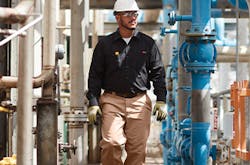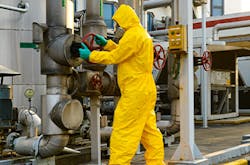By Eric Van Wely, Global Regulatory Affairs Manager for DuPont Personal Protection, and Reiyao Zhu, DuPont Personal Protection Global Application Development Leader for Oil, Gas & Chemicals
Workers in the oil & gas and petrochemical industries perform many high-risk tasks that involve exposure to multiple hazards. In some cases, these high-risk tasks are also performed under extreme weather conditions and in remote locations.
With so many different manufacturers offering PPE solutions, identifying and sourcing the most appropriate PPE can be very time-consuming for busy health, safety and environment (HSE) managers.
The following steps can help simplify the process of selecting PPE for oil & gas applications.
1. Hazard identification
Selection of PPE is the responsibility of employers under OSHA 1910.1321.
The first step in selecting the right PPE is to conduct a Site Hazard Identification and Risk Assessment. This may involve consultation with a number of colleagues to make sure that all potential hazards have been identified. Common sources of risk include potential flash fires; mechanical hazards; and exposure to hazardous chemicals, dusts and solvents.
In order to minimize risk, most safety professionals apply the “hierarchy of controls.” This essentially means that, if possible, you should eliminate the hazard completely. If this is not possible, you should substitute a safer option. Risks may be reduced by applying engineering and administrative controls to minimize potential contact. Once the risk reduction process is completed, PPE options can be selected to protect against any residual risk.
2. Matching PPE to the hazard
There are a number of essential properties to look for in PPE. This section gives some top-level guidance, but you should always consult with the PPE manufacturer to ensure the appropriate level of protection for your needs.
Flame resistance
Make sure you understand the basic differences between inherent and treated flame-resistant (FR) technologies.
- “Inherent” means that FR properties are a natural part of the fibers used in the fabric. The flame resistance is intrinsic, permanent and cannot be washed out or worn away.
- “Treated” fabrics use chemical additives to make them flame-resistant. The FR properties of chemically treated FR (FRT) fabrics – which are usually cotton or cotton/nylon blends – may be diminished or removed depending on how the fabrics are laundered and which chemicals they are exposed to.
Chemical exposure
Look for garments that exhibit:
- A strong permeation barrier built into the material to protect against a wide range of chemicals
- The ability to repel low concentrations of inorganic liquids and aerosols
- The ability to prevent solid particles from penetrating
Cut protection
It is likely that cut hazards will be encountered in combination with exposure to chemicals and/or extreme temperatures. Through advancements in materials technology, PPE manufacturers are able to offer protective gloves engineered with Kevlar® to help provide multi-hazard protection without compromising comfort and dexterity.
Arc flash protection
Electric arc flash is one of the most serious and least understood electrical hazards encountered in the workplace. An electric arc is a continuous electric discharge of high current which flows through an air gap between conductors. This generates a very bright ultra-violet light as well as intensive heat. An arc flash is typically caused by a short circuit.
Recent advances in PPE protection include the DuPont™ Nomex® global portfolio2. Included in the Nomex® global portfolio, Nomex® Essential Arc offers reliable, inherent flame and arc flash protection that meets NFPA 70E Category 2 requirements in a single layer, with enhanced garment durability for fewer replacements.
3. Regulatory compliance
It is also necessary to evaluate your PPE against regional and global standards. In the US, the provision of protective clothing is covered by OSHA 1910.1321. The main points of the legislation are:
- Employer shall determine the appropriate PPE that will protect employees from the hazard(s) identified.
- Employees must be consulted over the PPE and provided with instructions/training on its use and compatibility with other PPE.
- PPE must be provided and maintained by the employer free of charge to employees. The employer is also responsible for ensuring employee-owned PPE is adequately maintained.
- All PPE must not pose any increased risk due to the work environment, conditions, or the design of the PPE.
If you are responsible for selecting PPE centrally for use in an oil & gas company with global operations, you need to check the relevant legislation.
4. Design and comfort of PPE
PPE is only truly effective if it is used properly. Design and comfort both play a big role in employee acceptance. Consider the following:
- How comfortable (soft/lightweight) is the material?
- Do the garments fit well?
- How quickly does the material wick away or absorb moisture?
- How do workers properly don and doff garments?
- If the garment is reusable, how should it be cleaned and disinfected properly?
5. A word about COVID-19
The virus that causes COVID-19 has emerged as a global threat to the health of workers, placing additional responsibility on HSE professionals, particularly in essential industries like oil & gas.
As new guidance continues to evolve, it is extremely important to quickly adapt to the changing needs of workers. However, the same basic principles apply as for other forms of PPE.
- Evaluate the risk of exposure.
- Match the PPE solution to the hazard.
- Check PPE effectiveness in filtering out particulates, viruses, or bacteria.
- If PPE is reusable, how can it be decontaminated appropriately?
- Is the solution comfortable to wear?
6. Save time, stay safe
The PPE selection process can be complex, but there are ways that HSE managers can save time.
- Consult with an expert to help identify the specific combination of PPE for workers facing multiple hazards.
- Look for PPE manufacturers that have in-depth knowledge and expertise.
- Ask companies for resources that can help match PPE to the hazards your workers face.
- Choose a partner that works side-by-side with you to find the right PPE and can provide additional support such as training.
- Explore the Oil & Gas PPE Guidebook from DuPont Personal Protection to help select PPE based on your tasks and hazards.
Notes to editor
- Occupational Safety and Health Administration: Directive 1910.132 of November 18, 2016 on the minimum health and safety requirements for the use by workers of personal protective equipment at the workplace; 81 FR 82999 https://www.osha.gov/laws-regs/regulations/standardnumber/1910/1910.132
- The Nomex® global portfolio of fabric solutions is an extension of the DuPont Personal Protection Portfolio, which consists of DuPont™ Kevlar® aramid fiber for cut and mechanical protection, DuPont™ Tychem® garments liquid chemical and gas hazards, and DuPont™ Tyvek® garments particulate and light splash hazards. Tychem® and Tyvek® garments for Oil & Gas and Mining applications are also available through DuPont’s distributor network across the NA market.


